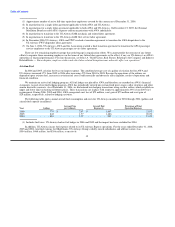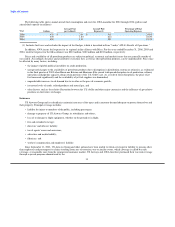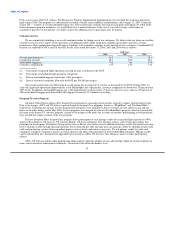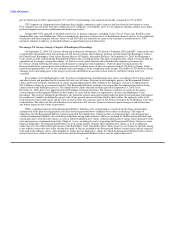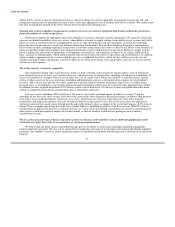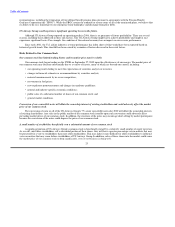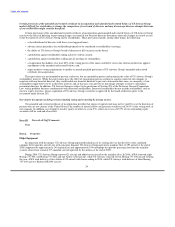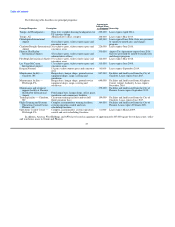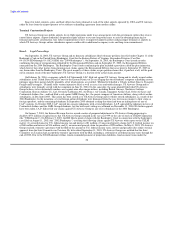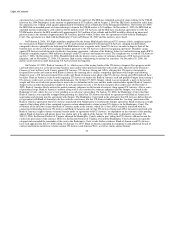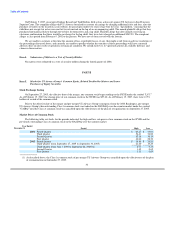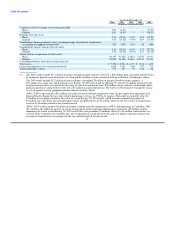US Airways 2006 Annual Report Download - page 25
Download and view the complete annual report
Please find page 25 of the 2006 US Airways annual report below. You can navigate through the pages in the report by either clicking on the pages listed below, or by using the keyword search tool below to find specific information within the annual report.
Table of Contents
Interruptions or disruptions in service at one of our hub airports could have a material adverse impact on our operations.
We operate principally through primary hubs in Charlotte, Philadelphia and Phoenix and secondary hubs/focus cities in Pittsburgh,
Las Vegas, New York, Washington, D.C. and Boston. A majority of our flights either originate in or fly into one of these locations. A
significant interruption or disruption in service at one of our hubs could result in the cancellation or delay of a significant portion of our
flights and, as a result, could have a severe impact on our business, operations and financial performance.
We are at risk of losses and adverse publicity stemming from any accident involving any of our aircraft.
If one of our aircraft were to be involved in an accident, we could be exposed to significant tort liability. The insurance we carry to
cover damages arising from any future accidents may be inadequate. In the event that our insurance is not adequate, we may be forced to
bear substantial losses from an accident. In addition, any accident involving an aircraft that we operate could create a public perception
that our aircraft are not safe or reliable, which could harm our reputation, result in air travelers being reluctant to fly on our aircraft and
adversely impact our financial condition and operations.
Our business is subject to weather factors and seasonal variations in airline travel, which cause our results to fluctuate.
Our operations are vulnerable to severe weather conditions in parts of our network that could disrupt service, create air traffic
control problems, decrease revenue, and increase costs, such as during hurricane season in the Caribbean and Southeast United States,
snow and severe winters in the Northeast United States and thunderstorms in the Eastern United States. In addition, the air travel business
historically fluctuates on a seasonal basis. Due to the greater demand for air and leisure travel during the summer months, revenues in the
airline industry in the second and third quarters of the year tend to be greater than revenues in the first and fourth quarters of the year. The
results of operations of the combined company will likely reflect weather factors and seasonality, and therefore quarterly results are not
necessarily indicative of those for an entire year, and the prior results of America West Holdings and US Airways Group are not
necessarily indicative of our future results.
The use of America West Holdings' and US Airways Group's respective pre-merger NOLs and certain other tax attributes could be
limited in the future.
As discussed below in Risks Related to Our Common stock — " A small number of stockholders beneficially own a substantial
amount of our common stock," a significant portion of US Airways Group's common stock is beneficially owned by a small number of
equity investors. Some of these shareholders have sold portions of their holdings since the merger. In the event these shareholders sell a
substantial portion of their shares in US Airways Group, each of US Airways Group and America West Holdings could be subject to an
"ownership change," as defined in Internal Revenue Code Section 382. An ownership change generally occurs if certain persons or
groups increase their aggregate ownership percentage in a corporation's stock by more than 50 percentage points in the shorter of any
three-year period or the period since the last ownership change. When a company undergoes such an ownership change, Section 382
limits the Company's future ability to utilize any net operating losses, or NOLs, generated before the ownership change and certain
subsequently recognized "built-in" losses and deductions, if any, existing as of the date of the ownership change. A company's ability to
utilize new NOLs arising after the ownership change is not affected.
Employee benefit plans represent significant continuing costs to the sponsoring employers.
US Airways Group and its subsidiaries sponsor employee benefit plans and arrangements that provide retirement, medical,
disability and other benefits to our employees and participating retirees. Many of the benefits provided under these plans are mandated
under various collective bargaining agreements, while others are provided on a voluntary basis as a means to recruit and retain valuable
employees. Benefit plans in general are increasingly the subject of protracted litigation, especially following significant plan changes.
Certain of the plans sponsored by the subsidiaries of US Airways Group underwent significant changes in connection with the recent
bankruptcy
22


